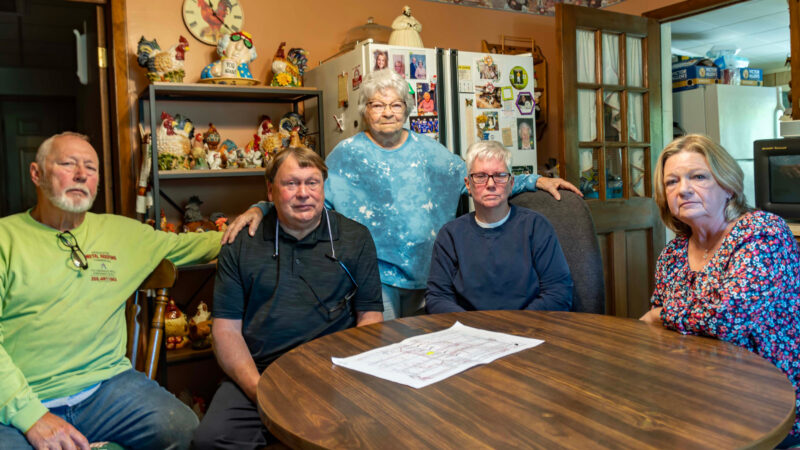Auburn Developing New “VaporWake” Bomb Dogs
 Auburn, Ala.– Three years ago, after spending almost nineteen billion dollars on hi-tech research, the Pentagon found the best bomb-detection devices in existence are dogs’ noses. But researchers at Auburn University are trying to make them even better. They’ve developed a new type of bomb-sniffing K-9 called a “VaporWake” dog. WBHM’s Southern Education Desk reporter Dan Carsen has more on this new tool in the anti-terrorism arsenal. Listen above (we did not transcribe puppy sounds, by the way), or read below.
Auburn, Ala.– Three years ago, after spending almost nineteen billion dollars on hi-tech research, the Pentagon found the best bomb-detection devices in existence are dogs’ noses. But researchers at Auburn University are trying to make them even better. They’ve developed a new type of bomb-sniffing K-9 called a “VaporWake” dog. WBHM’s Southern Education Desk reporter Dan Carsen has more on this new tool in the anti-terrorism arsenal. Listen above (we did not transcribe puppy sounds, by the way), or read below.
It’s not every day you hear future front-line terrorism-fighters aptly described as “butterfat.” But then again, it’s not every day — at least for the vast majority of us — that you get to see some of the most sought-after noses on earth in action.
“These are great dogs to deal with as you can see from looking at these five, healthy, butterfat little week-old Labrador retrievers,” says Jim Floyd, director of Auburn University’s Animal Health and Performance Program. “These are the detector dogs of the future that we hope are going to be out within a year protecting the public.”

Floyd and his colleagues breed, train, and study working animals to boost their abilities. Animal sports-medicine expert Craig Angle says the new VaporWake bomb dogs are like athletes. But in a way, they’re like artists, too.
“A singer, in order to sing properly and sing through two hours, he or she has to control breathing,” Angle says. “A dog has to be able to control its breathing. So we have to make sure that a dog has the respiratory capacity to not only be mobile, but once it gets to a target, to be able to sniff that target and decide whether or not it’s a suicide bomber.”
And that’s just part of it. Most bomb dogs hone in on stationary bags or containers. But VaporWake dogs’ noses are so acute, and their training so thorough, that they can ignore distractions and follow the scent trail — the vapor wake — of bombs as they’re being transported. And they can do it from hundreds of yards away. Think unobtrusive, sharp-nosed, highly trainable breeds like Labs, stationed in crowded airports, or train stations, or, say, at the Boston Marathon:
“Had one of our dogs been at that corner, the chances are very good that they would have detected that plume of explosive odor coming off of those backpacks,” says Floyd.
But the trick is getting the dogs to the right places — no easy task in the U.S. with so many transportation hubs and crowded venues. Even so, Birmingham-Southern College terrorism expert Randall Law says VaporWake dogs could be of real value.
“A more highly attuned canine bomb-sniffer could certainly be a valuable tool,” he says, “as long as it’s part of an arsenal and not an end-all-be-all.”
Auburn can’t divulge the number of VaporWake dogs in use because of contracts and security issues, but they are being used by the TSA, Capitol Police, Amtrak, and other agencies, and they’ve been at the past two presidential inaugurations.
Exactly how VaporWake dogs are trained is a trade secret, but like other dog training, it involves repetition, rewards, and staying a step ahead of some very smart animals to keep it interesting for them. Floyd says VaporWake dogs start with selective breeding, and the training intensifies through the first year. He adds, “Only a few dogs can train to that standard. They’ve been through a lot to allow us to say where they’re going to go, whether they have the ability to be a VaporWake dog, which is the top of the pyramid. And at that point we’ll hand them over to our commercial partners.”

Auburn researchers wanted to focus on research, so they recently signed a licensing agreement with private firm iK9, which took over the later stages of training, handler training, and distribution. The university has applied for a patent on its new VaporWake “canine technology.” But Angle says they’re actually building on something ancient.
“Wolves have to go out every day and find stuff that might be a mile, two miles downwind. And work to it. And it might be a rabbit, in a hole,” he points out. “And if they can’t do that, they’re not going to be able to eat that day … or reproduce and evolve over the last 10,000 years.”
For now, experts seem to agree the best bomb-detecting technology is biological and has four legs. And researchers, handlers, and the VaporWake dogs themselves are learning how to get better every day, cultivating ancient abilities to do something dogs have done for millennia: alert their human companions to potential threats.
Alabama coal mine keeps digging after hundreds of fines and a fatal explosion
Following the death of a grandfather, Crimson Oak Grove Resources has left a community afraid for their homes and lives. An expert warns one resident may need to evacuate her home while she still can.
Florida’s 6-week abortion ban will have a ‘snowball effect’ on residents across the South
Abortion rights advocates say the ban will likely force many to travel farther for abortion care and endure pregnancy and childbirth against their will.
Attitudes among Alabama lawmakers softening on Medicaid expansion
Alabama is one of ten states which has not expanded Medicaid. Republican leaders have pushed back against the idea for years.
Birmingham is 3rd worst in the Southeast for ozone pollution, new report says
The American Lung Association's "State of the Air" report shows some metro areas in the Gulf States continue to have poor air quality.
Why haven’t Kansas and Alabama — among other holdouts — expanded access to Medicaid?
Only 10 states have not joined the federal program that expands Medicaid to people who are still in the "coverage gap" for health care
Once praised, settlement to help sickened BP oil spill workers leaves most with nearly nothing
Thousands of ordinary people who helped clean up after the 2010 BP oil spill in the Gulf of Mexico say they got sick. A court settlement was supposed to help compensate them, but it hasn’t turned out as expected.







